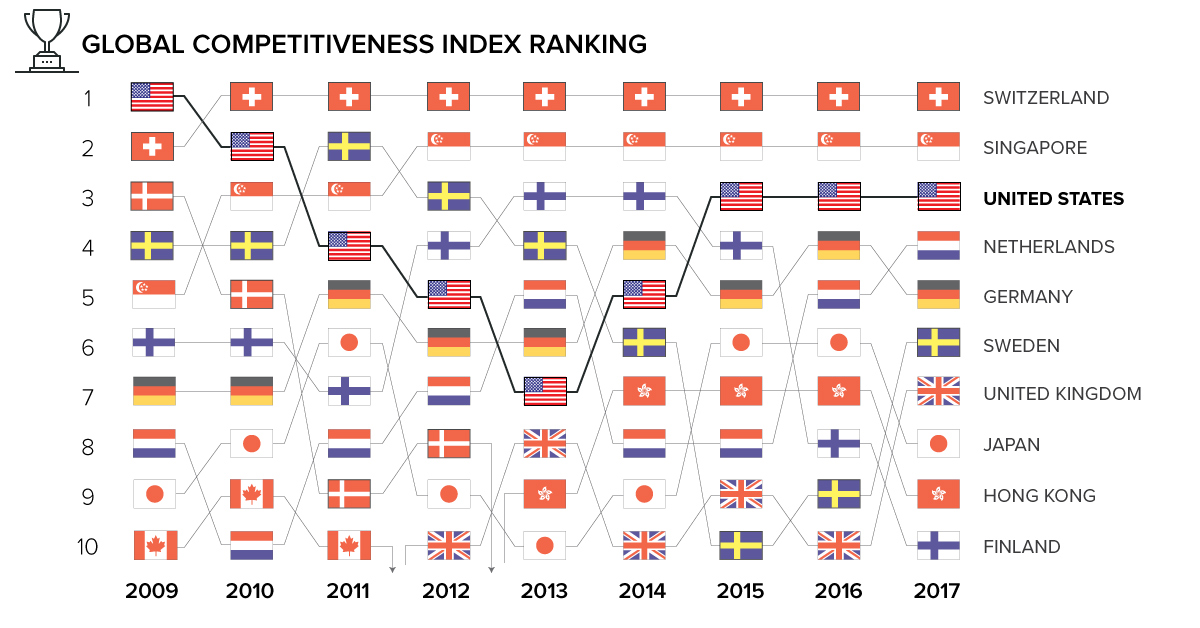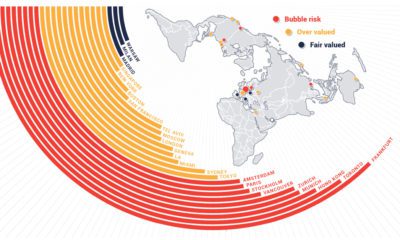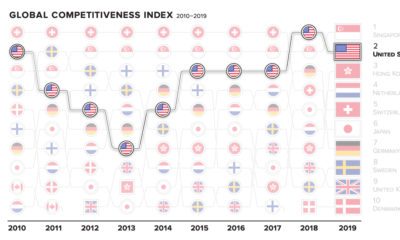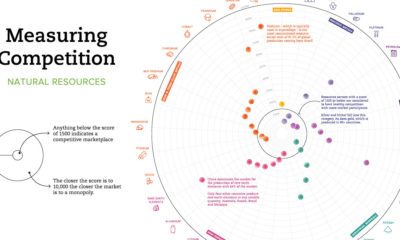Markets
Chart: Measuring Global Competitiveness
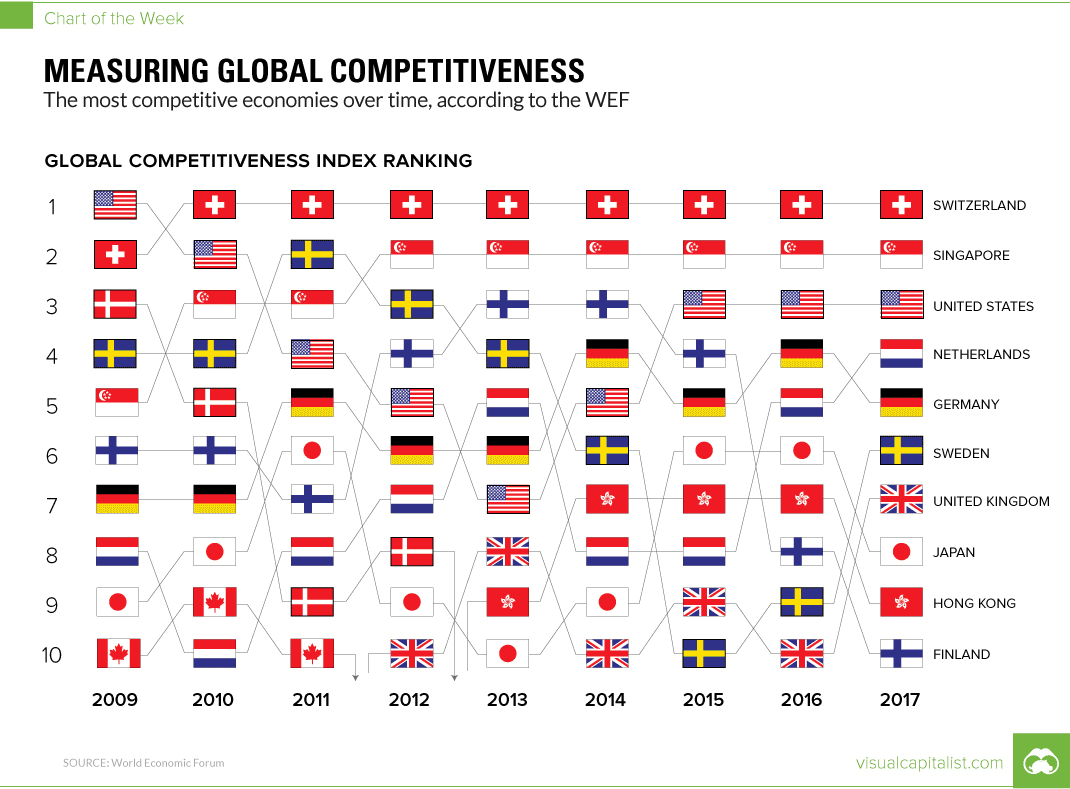
Chart: Measuring Global Competitiveness
The Chart of the Week is a weekly Visual Capitalist feature on Fridays.
What makes an economy competitive at the global level, and why?
It’s a question that economists, investors, and politicians have been asking themselves for decades. And to help answer it, the World Economic Forum has created the Global Competitiveness Index, or GCI.
How can we measure competitiveness?
To figure out how countries compare on the world stage, the GCI is calculated based on 114 economic metrics ranging from the quality of infrastructure to the amount of government debt.
This wide variety of metrics is organized into a set of 12 pillars, as follows:
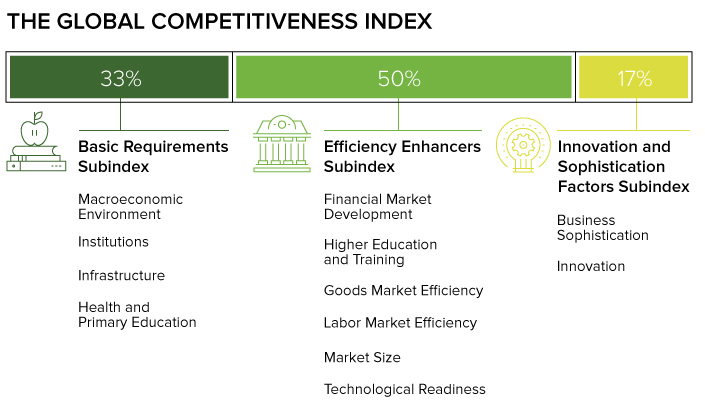
Global Competitiveness by Country
Based on the latest edition of the report, Switzerland (5.81) is the most competitive country in the world, having held the leading position since 2010 after it outpaced the United States (5.70) in the wake of the financial crisis.
| Rank | Country | Current Score (2016) | Previous Score (2015) | Change |
|---|---|---|---|---|
| 1 | Switzerland | 5.81 | 5.76 | 0.05 |
| 2 | Singapore | 5.72 | 5.68 | 0.04 |
| 3 | United States | 5.70 | 5.61 | 0.09 |
| 4 | Netherlands | 5.57 | 5.50 | 0.07 |
| 5 | Germany | 5.57 | 5.53 | 0.04 |
| 6 | Sweden | 5.53 | 5.43 | 0.10 |
| 7 | United Kingdom | 5.49 | 5.43 | 0.06 |
| 8 | Japan | 5.48 | 5.47 | 0.01 |
| 9 | Hong Kong | 5.48 | 5.46 | 0.02 |
| 10 | Finland | 5.44 | 5.45 | -0.01 |
| 11 | Norway | 5.44 | 5.41 | 0.03 |
| 12 | Denmark | 5.35 | 5.33 | 0.02 |
| 13 | New Zealand | 5.31 | 5.25 | 0.06 |
| 14 | Taiwan | 5.28 | 5.28 | 0.00 |
| 15 | Canada | 5.27 | 5.31 | -0.04 |
Picturing Competitiveness
Global competitiveness is a multi-faceted metric, but our understanding of it becomes clearer when compared with more standard measures such as GDP per capita (PPP).
The interactive graphic below from Knoema plots GDP per capita against GCI between 2006-2015, showing how the relationship between competitiveness and wealth has changed over time for numerous countries.
It is clear that competitiveness and GDP are positively correlated. In other words, the ability to be structurally and organizationally competitive creates conditions that are ideal for economic growth.
Don’t Worry, Be Happy
Competitiveness and growth in economic output may be related, but the infrastructure needed to stay globally competitive may confer other benefits to competitive ability and quality of life that go beyond GDP.
The Happy Planet Index (HPI) measures the sustainable well-being of citizens in any given country, and is plotted here against GCI.
The correlation between these factors is still positive, but weaker.
Rwanda, for example, is by statistical measure one of the world’s unhappiest nations (3.52 HPI); it is roughly equally competitive with the comparatively jubilant Costa Rican population (7.09 HPI), which also has a much higher GDP per capita.
On the other hand, a country can still be happy without being particularly competitive on a global basis. For example, Argentina (6.65 HPI) ranks in the bottom 50% of countries for global competitiveness (3.79 GCI).
Markets
The European Stock Market: Attractive Valuations Offer Opportunities
On average, the European stock market has valuations that are nearly 50% lower than U.S. valuations. But how can you access the market?

European Stock Market: Attractive Valuations Offer Opportunities
Europe is known for some established brands, from L’Oréal to Louis Vuitton. However, the European stock market offers additional opportunities that may be lesser known.
The above infographic, sponsored by STOXX, outlines why investors may want to consider European stocks.
Attractive Valuations
Compared to most North American and Asian markets, European stocks offer lower or comparable valuations.
| Index | Price-to-Earnings Ratio | Price-to-Book Ratio |
|---|---|---|
| EURO STOXX 50 | 14.9 | 2.2 |
| STOXX Europe 600 | 14.4 | 2 |
| U.S. | 25.9 | 4.7 |
| Canada | 16.1 | 1.8 |
| Japan | 15.4 | 1.6 |
| Asia Pacific ex. China | 17.1 | 1.8 |
Data as of February 29, 2024. See graphic for full index names. Ratios based on trailing 12 month financials. The price to earnings ratio excludes companies with negative earnings.
On average, European valuations are nearly 50% lower than U.S. valuations, potentially offering an affordable entry point for investors.
Research also shows that lower price ratios have historically led to higher long-term returns.
Market Movements Not Closely Connected
Over the last decade, the European stock market had low-to-moderate correlation with North American and Asian equities.
The below chart shows correlations from February 2014 to February 2024. A value closer to zero indicates low correlation, while a value of one would indicate that two regions are moving in perfect unison.
| EURO STOXX 50 | STOXX EUROPE 600 | U.S. | Canada | Japan | Asia Pacific ex. China |
|
|---|---|---|---|---|---|---|
| EURO STOXX 50 | 1.00 | 0.97 | 0.55 | 0.67 | 0.24 | 0.43 |
| STOXX EUROPE 600 | 1.00 | 0.56 | 0.71 | 0.28 | 0.48 | |
| U.S. | 1.00 | 0.73 | 0.12 | 0.25 | ||
| Canada | 1.00 | 0.22 | 0.40 | |||
| Japan | 1.00 | 0.88 | ||||
| Asia Pacific ex. China | 1.00 |
Data is based on daily USD returns.
European equities had relatively independent market movements from North American and Asian markets. One contributing factor could be the differing sector weights in each market. For instance, technology makes up a quarter of the U.S. market, but health care and industrials dominate the broader European market.
Ultimately, European equities can enhance portfolio diversification and have the potential to mitigate risk for investors.
Tracking the Market
For investors interested in European equities, STOXX offers a variety of flagship indices:
| Index | Description | Market Cap |
|---|---|---|
| STOXX Europe 600 | Pan-regional, broad market | €10.5T |
| STOXX Developed Europe | Pan-regional, broad-market | €9.9T |
| STOXX Europe 600 ESG-X | Pan-regional, broad market, sustainability focus | €9.7T |
| STOXX Europe 50 | Pan-regional, blue-chip | €5.1T |
| EURO STOXX 50 | Eurozone, blue-chip | €3.5T |
Data is as of February 29, 2024. Market cap is free float, which represents the shares that are readily available for public trading on stock exchanges.
The EURO STOXX 50 tracks the Eurozone’s biggest and most traded companies. It also underlies one of the world’s largest ranges of ETFs and mutual funds. As of November 2023, there were €27.3 billion in ETFs and €23.5B in mutual fund assets under management tracking the index.
“For the past 25 years, the EURO STOXX 50 has served as an accurate, reliable and tradable representation of the Eurozone equity market.”
— Axel Lomholt, General Manager at STOXX
Partnering with STOXX to Track the European Stock Market
Are you interested in European equities? STOXX can be a valuable partner:
- Comprehensive, liquid and investable ecosystem
- European heritage, global reach
- Highly sophisticated customization capabilities
- Open architecture approach to using data
- Close partnerships with clients
- Part of ISS STOXX and Deutsche Börse Group
With a full suite of indices, STOXX can help you benchmark against the European stock market.

Learn how STOXX’s European indices offer liquid and effective market access.

-

 Economy2 days ago
Economy2 days agoEconomic Growth Forecasts for G7 and BRICS Countries in 2024
The IMF has released its economic growth forecasts for 2024. How do the G7 and BRICS countries compare?
-

 Markets1 week ago
Markets1 week agoU.S. Debt Interest Payments Reach $1 Trillion
U.S. debt interest payments have surged past the $1 trillion dollar mark, amid high interest rates and an ever-expanding debt burden.
-

 United States2 weeks ago
United States2 weeks agoRanked: The Largest U.S. Corporations by Number of Employees
We visualized the top U.S. companies by employees, revealing the massive scale of retailers like Walmart, Target, and Home Depot.
-

 Markets2 weeks ago
Markets2 weeks agoThe Top 10 States by Real GDP Growth in 2023
This graphic shows the states with the highest real GDP growth rate in 2023, largely propelled by the oil and gas boom.
-

 Markets2 weeks ago
Markets2 weeks agoRanked: The World’s Top Flight Routes, by Revenue
In this graphic, we show the highest earning flight routes globally as air travel continued to rebound in 2023.
-

 Markets2 weeks ago
Markets2 weeks agoRanked: The Most Valuable Housing Markets in America
The U.S. residential real estate market is worth a staggering $47.5 trillion. Here are the most valuable housing markets in the country.
-

 Energy1 week ago
Energy1 week agoThe World’s Biggest Nuclear Energy Producers
-

 Money2 weeks ago
Money2 weeks agoWhich States Have the Highest Minimum Wage in America?
-

 Technology2 weeks ago
Technology2 weeks agoRanked: Semiconductor Companies by Industry Revenue Share
-

 Markets2 weeks ago
Markets2 weeks agoRanked: The World’s Top Flight Routes, by Revenue
-

 Countries2 weeks ago
Countries2 weeks agoPopulation Projections: The World’s 6 Largest Countries in 2075
-

 Markets2 weeks ago
Markets2 weeks agoThe Top 10 States by Real GDP Growth in 2023
-

 Demographics2 weeks ago
Demographics2 weeks agoThe Smallest Gender Wage Gaps in OECD Countries
-

 United States2 weeks ago
United States2 weeks agoWhere U.S. Inflation Hit the Hardest in March 2024
